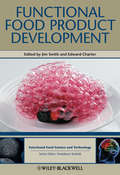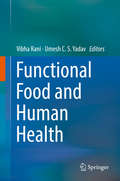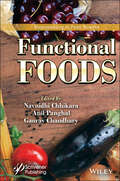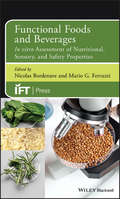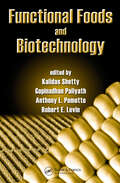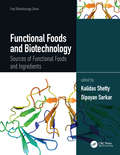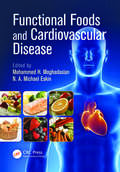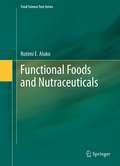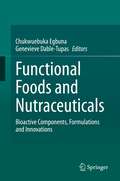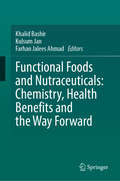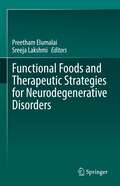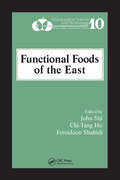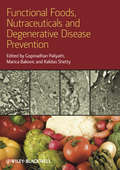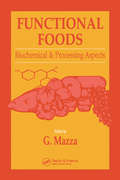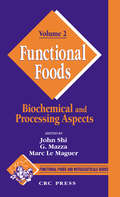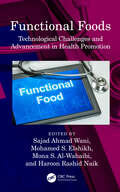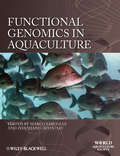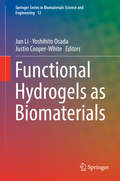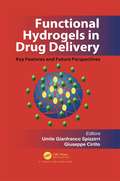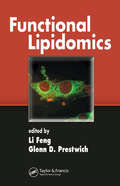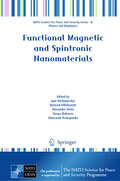- Table View
- List View
Functional Food Ingredients and Nutraceuticals: Processing Technologies, Second Edition (Functional Foods and Nutraceuticals)
by John ShiThe second edition of a bestseller, Functional Food Ingredients and Nutraceuticals: Processing Technologies covers new and innovative technologies for the processing of functional foods and nutraceuticals that show potential for academic use and broad industrial applications. The book includes a number of "green" separation and stabilization techno
Functional Food Product Development (Hui: Food Science and Technology #3)
by Jim Smith Edward CharterAccording to an August 2009 report from PricewaterhouseCoopers, the United States market for functional foods in 2007 was US$ 27 billion. Forecasts of growth range from between 8.5% and 20% per year, or about four times that of the food industry in general. Global demand by 2013 is expected to be about $100 billion. With this demand for new products comes a demand for product development and supporting literature for that purpose. There is a wealth of research and development in this area and great scope for commercialization, and this book provides a much-needed review of important opportunities for new products, written by authors with in-depth knowledge of as yet unfulfilled health-related needs. This book addresses functional food product development from a number of perspectives: the process itself; health research that may provide opportunities; idea creation; regulation; and processes and ingredients. It also features case studies that illustrate real product development and commercialization histories. Written for food scientists and technologists, this book presents practical information for use in functional food product development. It is an essential resource for practitioners in functional food companies and food technology centres and is also of interest to researchers and students of food science. Key features: A comprehensive review of the latest opportunities in this commercially important sector of the food industry Includes chapters highlighting functional food opportunities for specific health issues such as obesity, immunity, brain health, heart disease and the development of children. New technologies of relevance to functional foods are also addressed, such as emulsion delivery systems and nanoencapsulation. Includes chapters on product design and the use of functional ingredients such as antioxidants, probiotics and prebiotics as well as functional ingredients from plant and dairy sources Specific examples of taking products to market are provided in the form of case studies e.g. microalgae functional ingredients Part of the Functional Food Science and Technology book series (Series Editor: Fereidoon Shahidi)
Functional Food Products and Sustainable Health
by Saghir Ahmad Nasser Abdulatif Al-ShabibThere is a growing global awareness of the link between good diet and health. This fascinating book reviews various functional foods or nutraceuticals and the bio-active compounds they contain in order to identify the role of bioactive compounds such as nisin, micronutrients, and hydrocolloids in the diet in overall human health. It also provides up-to-date information on functional elements like antioxidants, dietary fibres, pre & probiotics, vitamins and mineral-enriched foods in the human diet. Consisting of fifteen chapters, the book offers a systematic review of the key factors in the preparation of functional foods from selected sources, and also describes the processing, preservation and packaging of a range of functional food products. This book is a valuable resource for students and researchers working in the field of food science, food technology, and nutrition, as well as for industry experts.
Functional Food and Human Health
by Vibha Rani Umesh C. YadavGlobal health and the increasing incidence of various diseases are a cause for concern, and doctors and scientists reason that the diet, food habits and lifestyle are contributing factors. Processed food has reduced the nutritional value of our diet, and although supplementing foods with various additives is considered an alternative, the long-term impact of this is not known. Many laboratories around the world are working to identify various nutritional components in our daily food and their effect on human health. These have been classified as Nutraceuticals or functional food, and they may have preventive and therapeutic effects in a number of pathologies associated with modern dietary habits and lifestyles. This book addresses various aspects of this issue, revitalizing the discussion and consolidating the latest research on nutritional and functional food and their effects in in-vitro, in-vivo and human clinical studies.
Functional Foods
by Gaurav Chaudhary Navnidhi Chhikara Anil PanghalFunctional Foods Presenting cutting-edge information on new and emerging food engineering processes, Functional Foods, the second volume in the groundbreaking new series, “Bioprocessing in Food Science,” is an essential reference on the modeling, quality, safety, and technologies associated with food processing operations today. Functional Foods, the second volume in series, “Bioprocessing in Food Science,” is an up-to-date, comprehensive volume covering the preparation, processes and health benefits of functional foods. Written and edited by a team of experts in the field, this important new volume provides readers extensive knowledge about different types of traditional and commercially available functional foods from different sources, such as milk, meat, cereals, millets and fruits and vegetables. The main objective of this book is to disseminate knowledge about the recent technologies developed in the field of functional foods to students, researchers, and industry professionals. This will enable them to make crucial decisions regarding the adoption, implementation, economics, and constraints of the different technologies. As the demand for healthy food is increasing, manufacturers are searching for new possibilities for occupying a growing share in the rapidly changing food market. Covering the use of conventional and non-conventional sources, prebiotics, probiotics and many other topics, with emphasis on their functionality in food systems, this volume also provides insights on the specific packaging requirements for functional foods with maximum illustrations of how to enhance shelf life and create superior quality products. The authors and editors discuss the need for regulatory frameworks, government bodies, guidelines, and their challenges within the context of the functional food market. Whether for the veteran engineer or scientist, the student, or a manager or other technician working in the field, this volume is a must-have for any library. This outstanding new volume: Discusses an overview of functional foods including global regulations, legislations and packaging requirements Provides knowledge of functional ingredients and health benefits of functional foods from different plants, animals, and microbes sources Acquaints the readers about technological aspects for functional ingredients delivery Addresses the basic to advanced aspects of different functional foods, combining the requirements, health benefits and regulations, showcasing the development of functional food products with potential functional benefits Audience: Process and chemical engineers, chemists, engineers in other disciplines, managers, researchers, scientists, students, and teachers working in the field of food engineering and processing
Functional Foods and Beverages: In vitro Assessment of Nutritional, Sensory, and Safety Properties (Institute of Food Technologists Series)
by Nicolas Bordenave Mario G. FerruzziA much-needed guide to in vitro food functionality evaluation principles, processes, and state-of-the-art modeling There are more than a few books devoted to the assessment of food functionality but, until now, there were no comprehensive guides focusing on the increasingly important subject of in vitro food evaluation. With contributions from the world’s foremost experts in the field, this book brings readers up to speed on the state-of-the-art in in vitro modeling, from its physiological bases to its conception, current uses, and future developments. Food functionality is a broad concept encompassing nutritional and health functionality, food safety and toxicology, as well as a broad range of visual and organoleptic properties of food. In vitro techniques bridge the gap between standard analytical techniques, including chemical and biochemical approaches and in vivo human testing, which remains the ultimate translational goal for evaluation of the functionality of food. Although it is a well- established field, in vitro food testing continues to evolve toward ever more accurate predictions of in vivo properties and outcomes. Both ethical and highly economical, these approaches allow for detailed mechanistic insights into food functionalities and, therefore, a better understanding of the interactions of food and human physiology. Reviews the core concepts of food functionality and functionality evaluation methodologies Provides an overview of the physiology of the gastrointestinal tract, including host-microbial interactions within it Delves into the physiology of sensory perception of food, taste and texture as they relate to in vitro modeling Explores the challenges of linking in vitro analysis of taste, aroma and flavor to their actual perception Addresses in vitro models of the digestion and absorption of macronutrients, micronutrients, and phytonutrients Describes in vitro evaluations of toxicants, allergens and other specific food hazards Functional Foods and Beverages is an indispensable working resource for food scientists as well as researchers working in government facilities dedicated to tracking food safety.
Functional Foods and Biotechnology: Biotransformation and Analysis of Functional Foods and Ingredients (Food Biotechnology Series)
by Kalidas Shetty Dipayan SarkarThe second book of the Food Biotechnology series, Functional Foods and Biotechnology: Biotransformation and Analysis of Functional Foods and Ingredients highlights two important and interrelated themes: biotransformation innovations and novel bio-based analytical tools for understanding and advancing functional foods and food ingredients for health-focused food and nutritional security solutions. The first section of this book provides novel examples of innovative biotransformation strategies based on ecological, biochemical, and metabolic rationale to target the improvement of human health relevant benefits of functional foods and food ingredients. The second section of the book focuses on novel host response based analytical tools and screening strategies to investigate and validate the human health and food safety relevant benefits of functional foods and food ingredients. Food biotechnology experts from around the world have contributed to this book to advance knowledge on bio-based innovations to improve wider health-focused applications of functional food and food ingredients, especially targeting non-communicable chronic disease (NCD) and food safety relevant solution strategies. Key Features: Provides system science-based food biotechnology innovations to design and advance functional foods and food ingredients for solutions to emerging global food and nutritional insecurity coupled public health challenges. Discusses biotransformation innovations to improve human health relevant nutritional qualities of functional foods and food ingredients. Includes novel host response-based food analytical models to optimize and improve wider health-focused application of functional foods and food ingredients. The overarching theme of this second book is to advance the knowledge on metabolically-driven food system innovations that can be targeted to enhance human health and food safety relevant nutritional qualities and antimicrobial properties of functional food and food ingredients. The examples of biotransformation innovations and food analytical models provide critical insights on current advances in food biotechnology to target, design and improve functional food and food ingredients with specific human health benefits. Such improved understanding will help to design more ecologically and metabolically relevant functional food and food ingredients across diverse global communities. The thematic structure of this second book is built from the related initial book, which is also available in the Food Biotechnology Series Functional Foods and Biotechnology: Sources of Functional Food and Ingredients, edited by Kalidas Shetty and Dipayan Sarkar (ISBN: 9780367435226) For a complete list of books in this series, please visit our website at: https://www.crcpress.com/Food-Biotechnology-Series/book-series/CRCFOOBIOTECH
Functional Foods and Biotechnology: Sources Of Functional Foods And Ingredients (Food Biotechnology Series)
by Kalidas Shetty Gopinadhan Paliyath Robert E. Levin Anthony L. PomettoWorld-wide there are more overweight and obese people (1 billion) than there are malnourished (0.8 billion). Today the challenge lies not just in meeting basic nutritional needs, but providing additional protective ingredients to help prevent the major chronic diseases associated with obesity. Biotechnology has become an important tool in recent ye
Functional Foods and Biotechnology: Sources of Functional Foods and Ingredients (Food Biotechnology Series)
by Kalidas Shetty Dipayan SarkThe first of two related books that kick off the Food Biotechnology series, Functional Foods and Biotechnology: Sources of Functional Foods and Ingredients, focuses on the recent advances in the understanding of the role of cellular, metabolic, and biochemical concepts and processing that are important and relevant to improve functional foods and food ingredients targeting human health benefits. This volume explores sources of ecologically-based diversity of functional foods and food ingredients that are available to enhance diverse nutritional values and functional benefits of foods for better human health outcomes, especially focusing on emerging diet and lifestyle-linked non-communicable chronic disease (NCDs) challenges. The contributors with expertise in the field of Food Biotechnology and Functional Food Ingredients have integrated the recent advances in some common as well as novel sources of functional foods and ingredients from diverse ecological and cultural origins. Further, these chapters also highlight human health relevant bioactive profiles and associated functionalities of these health-promoting compounds, including preventative functional roles for common NCD-linked health benefits. FEATURES: Provides ecological and metabolic rational to integrate novel functional food and functional ingredient sources in wider health-focused food system innovations. Examines the value-added role of select functional foods and food ingredients to improve NCD-linked health benefits such as type-2 diabetes, cardiovascular disease, and human gut improvement Includes insights on system-based solutions to advance climate resilient and health focused food diversity based on diverse biotechnological approaches to design and integrate functional food and food ingredient sources Overall, the rationale of this book series is focused on Metabolic-Driven Rationale to Advance Biotechnological Approaches for Functional Foods, the synopsis of which is presented as the Introduction chapter, which is followed by a chapter on current understanding about regulatory guidelines for health claims of functional foods and food ingredients. Special topics on nonnutritive sweeteners, caroteneprotein from seafood waste, and Xylooligosaccharides as functional food ingredients for health-focused dietary applications are integrated in this book. Additionally, ecologically and metabolically-driven functional roles of common food sources such as corn, and barley and some novel food sources, such as ancient emmer wheat, black soybean, fava bean, herbs from Lamiaceae and functional protein ingredients and minerals from Lemnaceae are also highlighted in this volume. The overall goal is to provide insights on role of these functional food and ingredient sources for their integration in wider health-focused food systems, which will help food scientists, food industry personnel, nutritionists, crop science researchers, public health professionals, and policy makers to make appropriate decisions and to formulate strategies for improving health and well-being. A related book focuses on biological and metabolically driven mobilization of functional bioactives and ingredients and their analysis that is relevant in health and wellness.
Functional Foods and Cardiovascular Disease
by Mohammed H. Moghadasian N. A. Michael EskinCardiovascular disease remains the number one killer in North America and around the world. The staggering medical costs involved in treating patients suffering from this disease demand an alternative approach to prevent or minimize its development. In Functional Foods and Cardiovascular Disease, international researchers reveal essential up-to-dat
Functional Foods and Dietary Supplements: Processing Effects and Health Benefits
by Imran Ahmad Athapol Noomhorm Anil Kumar AnalFunctional foods are foods which contain bioactive components, either from plant or animal sources, which can have health benefits for the consumer over and above their nutritional value. Foods which have antioxidant or cancer-combating components are in high demand from health conscious consumers: much has been made of the health-giving qualities of fruits and vegetables in particular. Conversely, foods which have been processed are suffering an image crisis, with many consumers indiscriminately assuming that any kind of processing robs food of its “natural goodness”. To date, there has been little examination of the actual effects – whether positive or negative – of various types of food processing upon functional foods. This book highlights the effects of food processing on the active ingredients of a wide range of functional food materials, with a particular focus on foods of Asian origin. Asian foods, particularly herbs, are becoming increasingly accepted and demanded globally, with many Western consumers starting to recognize and seek out their health-giving properties. This book focuses on the extraction of ingredients which from materials which in the West are seen as “alternative” - such as flour from soybeans instead of wheat, or bran and starch from rice – but which have long histories in Asian cultures. It also highlight the incorporation of those bioactive compounds in foods and the enhancement of their bioavailability. Functional Foods and Dietary Supplements: Processing Effects and Health Benefits will be required reading for those working in companies, research institutions and universities that are active in the areas of food processing and agri-food environment. Food scientists and engineers will value the new data and research findings contained in the book, while environmentalists, food regulatory agencies and other food industry personnel involved in functional food production or development will find it a very useful source of information.
Functional Foods and Nutraceuticals
by Rotimi E. Aluko"Functional food or medicinal food is any fresh or processed food claimed to have a health-promoting and/or disease-preventing property beyond the basic nutritional function of supplying nutrients, although there is no consensus on an exact definition of the term. This is an emerging field in food science, in which such foods are usually accompanied by health claims for marketing purposes, such as a company's 'cereal is a significant source of fiber. Studies have shown that an increased amount of fiber in one's diet can decrease the risk of certain types of cancer in individuals.' Functional foods are sometimes called nutraceuticals, a portmanteau of nutrition and pharmaceutical, and can include food that has been genetically modified. The general category includes processed food made from functional food ingredients, or fortified with health-promoting additives, like "vitamin-enriched" products, and also fresh foods (e.g., vegetables) that have specific claims attached. Fermented foods with live cultures are often also considered to be functional foods with probiotic benefits."
Functional Foods and Nutraceuticals: Bioactive Components, Formulations and Innovations
by Chukwuebuka Egbuna Genevieve Dable-TupasFunctional foods and nutraceuticals are food products that naturally offer or have been modified to offer additional health benefits beyond basic nutrition. As such products have surged in popularity in recent years, it is crucial that researchers and manufacturers understand the concepts underpinning functional foods and the opportunity they represent to improve human health, reduce healthcare costs, and support economic development worldwide.Functional Foods and Nutraceuticals: Bioactive Components, Formulations and Innovations presents a guide to functional foods from experienced professionals in key institutions around the world. The text provides background information on the health benefits, bioavailability, and safety measurements of functional foods and nutraceuticals. Subsequent chapters detail the bioactive components in functional foods responsible for these health benefits, as well as the different formulations of these products and recent innovations spurred by consumer demands. Authors emphasize product development for increased marketability, taking into account safety issues associated with functional food adulteration and solutions to be found in GMP adherence. Various food preservation methods aimed at enhancing the quality and shelf life of functional food are also highlighted. Functional Foods and Nutraceuticals: Bioactive Components, Formulations and Innovations is the first of its kind, designed to be useful to students, teachers, nutritionists, food scientists, food technologists and public health regulators alike.
Functional Foods and Nutraceuticals: Chemistry, Health Benefits and the Way Forward
by Farhan Jalees Ahmad Khalid Bashir Kulsum JanProgress in understanding the association between the health benefits of foods, prevention of diseases and immunity enhancers has led researchers to focus on functional components of foods. Considerable evidence from epidemiological, clinical and laboratory studies have shown numerous functional components in foods which may enhance immunity and help in preventing various lifestyle diseases. This book specifically documents the therapeutic roles of functional foods and their ingredients and explains their bioavailability and accessibility. Functional Foods and Nutraceuticals: Chemistry, Health Benefits and the Way Forward addresses recent advances and future prospects of health benefits in different functional foods. It also provides a thorough understanding of the bioavailability of fortificants, their mechanisms of action, extraction techniques, effects of processing, nutraceutical and nanomaterial development and legislation. The book also delivers up-to-date information regarding the techniques of fortification, their bio-accessibility and trends along with the application of nanotechnology for the development of functional foods. This text serves as a multidisciplinary source appropriate for researchers from food science and technology, biotechnology, pharmaceutical and allied sciences, Provides recent advances in extraction of phytochemicalsExplores the role of Nutraceuticals as immunity boosters and in combatting lifestyle diseases
Functional Foods and Therapeutic Strategies for Neurodegenerative Disorders
by Preetham Elumalai Sreeja LakshmiThis book provides a comprehensive summary of the latest knowledge regarding functional foods and new therapeutic strategies for neurodegenerative disorders through explaining specific mechanisms for natural remedies and functional foods as well as alternative treatment and supplementary approaches for neurodegenerative diseases. Many relevant topics are covered, including role of prebiotics, recent applications for dietary polyphenols, marine bioactive compounds for neuro disorders, and age-related disorders. The roles of various remedies and functional foods are explained for various types of diseases, and the book also integrates the role of functional foods and remedies to work with the current therapeutics that are taking place. In parallel, the information presented through this book will also stimulate current status of leading contemporary methods for prohylactic and diagnostic practices, comprising nanoparticles, biomarkers, in silico techniques, and CRISPR-mediated genome editing–based therapy. The book will be essential reading for students and researchers with an interest in natural medicine, drug development, and food therapeutic strategies. In presenting new results and approaches and identifying areas for future research, it will also be of benefit for specialists in the field.
Functional Foods of the East
by Fereidoon Shahidi John Shi Chi-Tang HoHealth and healing foods have a long history in the Asian cultures. Those of Eastern culture have long believed that food and medicine are from the same source and can treat illnesses and promote a healthier life. This volume covers certain traditional Asian functional foods, their history, functionality, health benefits, physiological properties,
Functional Foods, Nutraceuticals, and Degenerative Disease Prevention
by Kalidas Shetty Gopinadhan Paliyath Marica BakovicFunctional Foods, Nutraceuticals and Degenerative Disease Prevention is a compilation of different segments of functional foods and nutraceuticals focusing on their mechanism of action in the human body leading to disease prevention. Numerous chapters deal with different functional foods in terms of their efficacy, highlighting the mechanism of action of their ingredients. The book focuses on the biochemistry and molecular biology of the disease prevention process rather than simply compiling the benefits of functional foods and nutraceuticals. Aimed primarily at an audience comprised of researchers, industry professionals, food scientists, medical professionals and graduate level students, Functional Foods, Nutraceuticals and Degenerative Disease Prevention offers a mechanism-based interpretation for the effect of nutraceuticals within the human body. Ultimately, the discussion of the biological effects of a variety of functional foods will provide a wholesome approach to the maintenance of health through judicious choice of functional foods.
Functional Foods: Biochemical and Processing Aspects, Volume 1
by G. MazzaThis reference provides a comprehensive treatment of the physiological effects of foods and food components capable of promoting good health and preventing or alleviating diseases. It assembles extensive information on the nature and physiological effects of biologically-active components of major plant foods. Internationally renowned specialists discuss how to manufacture and evaluate food products with health enhancing effects, using both traditional and novel processing methods. This comprehensive volume serves the information needs of food scientists and technologists, food process engineers, biochemists, nutritionists, and public health professionals.
Functional Foods: Biochemical and Processing Aspects, Volume 2 (Functional Foods and Nutraceuticals)
by John Shi G. Mazza Marc Le MaguerBuilding upon the success of the bestselling first volume, Functional Foods: Biochemical and Processing Aspects, Volume II explores new sources of nutraceutical and functional food ingredients and addresses crucial issues for product development and processing. It presents the latest developments in the chemistry, biochemistry, pharmacology, epidem
Functional Foods: Technological Challenges and Advancement in Health Promotion
by Sajad Ahmad Wani, Mohamed S. Elshikh, Mona S. Al-Wahaibi, and Haroon Rashid NaikIt is reported Functional foods are highly nutritious and associated with a number of powerful health benefits. They may protect against disease, prevent nutrient deficiencies, and promote proper growth and development. Functional Foods: Technological Challenges and Advancement in Health Promotion presents information related to bioactive compounds present in the functional foods, derived from fruits and vegetables, cereals and pulses, dairy and meat, herbs and spices and other foods. It describes novel techniques and methodologies used in the extraction, isolation, encapsulation, identification and characterization of bioactive compounds. Key Features: Covers the most recent research related to the bioactive compounds present in the functional foods Presents the latest information on extraction, isolation, encapsulation, identification and characterization Discusses formulation challenges with an emphasis on stability and safety evaluations of functional foods Finally, it includes substantial and scientific research and innovation for new product development with health benefits. This book will serve as a valuable resource for researchers, academicians, and students interested in many aspects of functional foods.
Functional Genomics in Aquaculture
by Zhanjiang John Liu Marco SarogliaGenomics has revolutionized biological research over the course of the last two decades. Genome maps of key agricultural species have offered increased understanding of the structure, organization, and evolution of animal genomes. Building upon this foundation, researchers are now emphasizing research on genome function. Published with the World Aquaculture Society, Functional Genomics in Aquaculture looks at the advances in this field as they directly relate to key traits and species in aquaculture production.Functional Genomics in Aquaculture opens with two chapters that provide a useful general introduction to the field of functional genomics. The second section of the book focuses on key production traits such as growth, development, reproduction, nutrition, and physiological response to stress and diseases. The final five chapters focus on a variety of key aquaculture species. Examples looking at our understanding of the functional genomes of salmonids, Mediterranean sea bass, Atlantic cod, catfish, shrimp, and molluscs, are included in the book.Providing valuable insights and discoveries into the functional genomes of finfish and shellfish species, Functional Genomics in Aquaculture, will be an invaluable resource to researchers and professionals in aquaculture, genetics, and animal science.
Functional Hydrogels as Biomaterials (Springer Series in Biomaterials Science and Engineering #12)
by Jun Li Yoshihito Osada Justin Cooper-WhiteThis book introduces readers to the latest advances in hydrogel biomaterials, mainly focusing on the emerging areas of synthetic and biopolymer hydrogels formed through specially designed chemical or physical crosslinking, and the cyclodextrin-based host-guest supramolecular self-assembly, for cell encapsulation, cell expansion, cell differentiation and tissue repair, stem cell culture, and cellular therapy and drug delivery applications. The book was written by experts at the forefront of these interdisciplinary areas and is intended for all researchers working in the fields of biomaterials and biomedical engineering, as well as medical professions. Jun Li is a Professor at the Department of Biomedical Engineering, National University of Singapore, Singapore. Yoshihito Osada is a Professor at RIKEN Advanced Science Institute, Japan. Justin Cooper-White is a Professor at the Australian Institute for Bioengineering and Nanotechnology, University of Queensland, Australia.
Functional Hydrogels in Drug Delivery: Key Features and Future Perspectives
by Giuseppe Cirillo Umile Gianfranco SpizzirriThe book deals with the synthesis and characterization of hydrogels specifically used as drug delivery systems. Each chapter includes the most recent updates about the different starting materials employed and the improvement of their physicochemical and biological properties to synthetize high performing carriers for specific uses.
Functional Lipidomics
by Li Feng Glenn D. PrestwichLipids play an essential role in cell signaling and subcellular structure. Systematic analysis of the total lipid structure of a cell or organism, the lipodome, can reveal novel avenues of therapeutic intervention and diagnosis. This analysis is best modeled after the lessons learned from proteomics. With contributions from pioneering researchers f
Functional Magnetic and Spintronic Nanomaterials (NATO Science for Peace and Security Series B: Physics and Biophysics)
by Igor Vladymyrskyi Burkard Hillebrands Denys Makarov Alexander Serga Oleksandr ProkopenkoMacroscopic objects made of magnetic materials have been known to mankind for several thousand years and are widely used in various fields of human activity. With the development and practical implementation of microelectronics, and more recently nanoelectronics, it has become possible to develop and manufacture magnetic nanomaterials, dramatically expanding the scope of magnetics in modern technologies. Today, magnetic nanomaterials and nanostructures are key components of advanced information technologies. They are widely used in eMobility, medicine, sensors, robotics, etc., and have significant potential for application in prospective smart wearables and human-machine interfaces. This volume outlines recent research in the field of functional magnetic and spintronic materials. Each of the 10 chapters in the volume is self-contained, allowing the topics to be explored independently of the material in other chapters. The book covers the entire “life cycle” of magnetic/spintronic nanomaterials: from theoretical and numerical studies of their properties (Ch. 1), fabrication and experimental study of film systems (Ch. 2), fabrication of nanostructures (Ch. 3), study of electromagnetic phenomena occurring in such nanostructures (Chs. 4-10), to the use of these nanostructures in new technologies, particularly in spintronic energy harvesting (Ch. 9) and quantum sensing (Ch. 10). Some of the contributions to this volume were presented as lectures and reports at the Advanced Research Workshop “Functional Spintronic Nanomaterials for Radiation Detection and Energy Harvesting” (25–27 September 2023, Kyiv, Ukraine), which was supported by the NATO Science for Peace and Security Programme.

